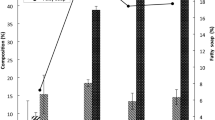Abstract
Microwave has nonthermal effects on enzymatic reactions, mainly caused by the polarities of the solvents and substrates. In this experiment, a model reaction with caprylic acid and butanol that was catalyzed by lipase from Mucor miehei in alkanes or arenes was employed to investigate the nonthermal effect in nonaqueous enzymatic esterification. With the comparison of the esterification carried by conventional heating and consecutive microwave irradiation, the positive nonthermal effect on the initial reaction rates was found substrate concentration-dependent and could be vanished ostensibly when the substrate concentration was over 2.0 mol L−1. The polar parameter log P well correlates the solvent polarity with the microwave effect, comparing to dielectric constant and assayed solvatochromic solvent polarity parameters. The log P rule presented in conventional heating-enzymatic esterification still fits in the microwaved enzymatic esterification. Alkanes or arenes with higher log P provided positive nonthermal effect in the range of 2 ≤ log P ≤ 4, but yielded a dramatic decrement after log P = 4. Isomers of same log P with higher dielectric constant received stronger positive nonthermal effect. With lower substrate concentration, the total log P of the reaction mixture has no obvious functional relation with the microwave effect.






Similar content being viewed by others
Abbreviations
- MI:
-
Initial reaction rate of microwaved reactions
- CH:
-
Initial reaction rate of conventional heated reactions
- MI/CH:
-
The microwave effect presented as the ratio of MI to CH
References
Yang, R. J., & Zhao, W. (2010). Journal of Physical Chemistry B, 114, 503–510.
Liaquat, M. (2011). Journal of Molecular Catalysis B: Enzymatic, 68, 59–65.
Chattopadhyay, S., Karemore, A., Das, S., Deysarkar, A., & Sen, R. (2011). Applied Energy, 88, 1251–1256.
Gupta, M. N., & Solanki, K. (2011). Bioorganic & Medicinal Chemistry Letters, 21, 2934–2936.
Zhang, M., Ding, M. L., Zhang, T., & Yang, J. M. (2010). Chemical Journal of Chinese Chinese Universities, 31, 612–615.
Kim, I. H., & Lee, S. M. (2006). Journal of Food Science, 71, C378–C382.
Piyatheerawong, W., Yamane, T., Nakano, H., & Iwasaki, Y. (2006). Journal of the American Oil Chemists’ Society, 83, 603–607.
Tsuchiya, D., Murakami, Y., Ogoma, Y., Kondo, Y., Uchio, R., & Yamanaka, S. (2005). Journal of Molecular Catalysis B: Enzymatic, 35, 52–56.
Kojima, Y., Sakuradani, E., & Shimizu, S. (2006). Journal of Bioscience and Bioengineering, 102, 179–183.
Réjasse, B., Lamare, S., Legoy, M. D., & Besson, T. (2004). Organic & Biomolecular Chemistry, 2, 1086–1089.
La Cara, F., Scarffi, M. R., D’Auria, S., Massa, R., d’Ambrosio, G., Franceschetti, G., Rossi, M., & De Rosa, M. (1999). Bioelectromagnetics, 20, 172–176.
de Souza, R. O. M. A., Antunes, O. A. C., Kroutil, W., & Kappe, C. O. (2009). Journal of Organic Chemistry, 74, 6157–6162.
Besson, T., Rejasse, B., Lamare, S., & Legoy, M. D. (2007). Journal of Enzyme Inhibition and Medicinal Chemistry, 22, 518–526.
Lin, S. S., Wu, C. H., Sun, M. C., Sun, C. M., & Ho, Y. P. (2005). Journal of the American Society for Mass Spectrometry, 16, 581–588.
Gaber, M. H., El Halim, N. A., & Khalil, W. A. (2005). Bioelectromagnetics, 26, 194–200.
Huang, W., Xia, Y. M., Gao, H., Fang, Y. J., Wang, Y., & Fang, Y. (2005). Journal of Molecular Catalysis B: Enzymatic, 35, 113–116.
Laane, C., Boeren, S., Vos, K., & Veeger, C. (1987). Biotechnology and Bioengineering, 30, 81–87.
Fang, Y., Huang, W., & Xia, Y. M. (2008). Process Biochemistry, 43, 306–310.
Chaudhary, A. K., Kamat, S. V., Beckman, E. J., Russell, A. J., Nurok, D., Kleyle, R. M., et al. (1996). Journal of the American Chemical Society, 118, 12891–12901.
Reichardt, C. (2003). Solvents and Solvent Effects in Organic Chemistry, 3rd Edition. Wiley−VCH: Weinheim, Germany, 418–424.
Reichardt, C. (1994). Chemical Reviews, 94, 2319–2358.
Dong, D. C., & Winnik, M. A. (1984). Canadian Journal of Chemistry, 62, 2560–2565.
Catalán, J., López, V., Pérez, P., Martin-Villamil, R., & Rodríguez, J. G. (1995). Liebigs Annalen, 1995, 241–252.
Abraham, M. H., Grellier, P. L., Abboud, J. L. M., Doherty, R. M., & Taft, R. W. (1988). Canadian Journal of Chemistry, 66, 2673–2686.
Muensterer, H., Kresze, G., Lamm, V., & Gieren, A. (1983). The Journal of Organic Chemistry, 48, 2833–2837.
Bezbradica, D., Mijin, D., Siler-Marinkovic, S., & Knezevic, Z. (2007). Journal of Molecular Catalysis B: Enzymatic, 45, 97–101.
Min, R., Fang, Y., & Xia, Y. M. (2009). Spectroscopy and Spectral Analysis, 29, 428–431.
Acknowledgments
We thank Ms. Xu Qing at Novozymes (China) Biotechnology Co., Ltd for generously providing lipase. This research work is supported by National Natural Science Foundation of China (31171752), Returned Overseas Chinese Scholars and the Keygrant Project of Chinese Ministry of Education (No 311002) and Research Fund for Doctoral Candidate of Jiangnan University (JUDCF10034).
Author information
Authors and Affiliations
Corresponding author
Rights and permissions
About this article
Cite this article
Wan, Hd., Sun, Sy., Hu, Xy. et al. Nonthermal Effect of Microwave Irradiation in Nonaqueous Enzymatic Esterification. Appl Biochem Biotechnol 166, 1454–1462 (2012). https://doi.org/10.1007/s12010-012-9539-5
Received:
Accepted:
Published:
Issue Date:
DOI: https://doi.org/10.1007/s12010-012-9539-5




